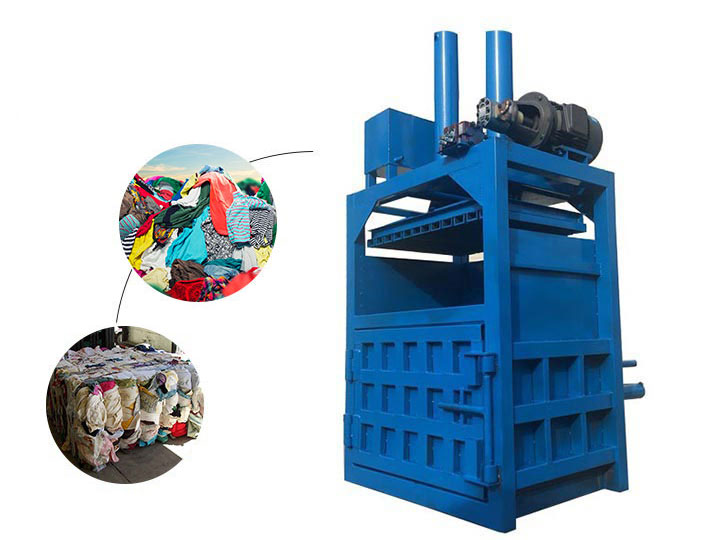The fashion industry has witnessed unprecedented growth over the years, leading to an alarming increase in textile waste. As the need for sustainable practices intensifies, finding effective solutions for textile waste management becomes imperative. Clothing balers have emerged as a game-changer in this regard, offering a comprehensive solution for compacting and recycling clothing waste. This article serves as a complete guide to clothing balers, providing insights into their purpose, functioning, benefits, and considerations for implementation.
Understanding Clothing Baler
Clothing baler is specialized machines designed to compress and bind clothing items into tightly compacted bales. These bales streamline storage, transportation, and recycling processes, optimizing efficiency in textile waste management. Clothing balers utilize hydraulic or pneumatic mechanisms to apply pressure, compacting clothing items tightly before securing them with binding material such as wire or strapping.

The Advantages of Clothing Baler
- Efficient Storage and Transportation:
Clothing balers significantly optimize storage space by compressing clothing items into compact bales. This efficient use of space allows businesses, retailers, and textile recycling centers to store larger quantities of clothing waste without requiring excessive storage area. Furthermore, the compact bales simplify transportation, enabling more efficient logistics and reducing the associated costs. - Cost Savings and Revenue Generation:
By implementing clothing balers, businesses can realize substantial cost savings. Reduced waste volume means fewer waste disposal trips, resulting in lower waste management expenses. Moreover, compact bales of clothing items have a higher market value in recycling markets, generating additional revenue from the sale of recycled materials. This dual benefit enhances the economic viability of textile waste management operations. - Environmental Impact and Sustainable Practices:
Clothing balers play a pivotal role in mitigating the environmental impact of textile waste. By compacting and bundling clothing items, these balers reduce the space occupied in landfills, conserving valuable land resources. Recycling the compacted clothing waste promotes a circular economy, minimizing the need for virgin resources and reducing carbon emissions associated with textile production. Implementing clothing balers aligns with sustainable practices, contributing to a greener and more responsible fashion industry.
Working Principles of Clothing Baler
Clothing balers follow a step-by-step process to effectively compress and bind clothing items. The main steps include:
- Loading: Clothing items are placed into the baler’s loading chamber manually or through an automated feeding system.
- Compression: Once the loading chamber is filled, the baler exerts hydraulic or pneumatic pressure to compress the clothing items tightly.
- Binding: After compression, the baler employs a binding mechanism to secure the bales. This typically involves using wire or strapping to hold the compacted clothing items in place.
- Ejection: Once the baling process is complete, the baler ejects the compacted bales, ready for storage or transportation.
Considerations for Choosing a Clothing Baler
Several factors should be considered when selecting a clothing baler:
- Capacity and Throughput: Assess the volume of clothing waste generated to determine the required capacity and throughput of the baler.
- Space Availability: Consider the available space for installation and operation of the clothing baler, ensuring it fits within the designated area.
- Power Source: Evaluate power source options (electric, hydraulic, pneumatic) based on energy efficiency, availability, and compatibility with existing infrastructure.
- Maintenance and Servicing: Determine the maintenance requirements of the baler, including regular servicing, spare parts availability, and technical support.
Safety Measures and Operating Guidelie
Operators should adhere to strict safety measures and guidelines when working with clothing balers:
- Operator Training: Ensure operators receive proper training on the safe operation of clothing balers, including the correct usage of controls, safety procedures, and emergency protocols.
- Safety Precautions: Emphasize the importance of wearing appropriate personal protective equipment (PPE), such as gloves and safety goggles, to prevent injuries.
- Emergency Stop Features: Familiarize operators with the location and operation of emergency stop buttons or switches in case of any hazards or malfunctions.
- Proper Handling: Educate operators on the correct handling techniques for clothing items, emphasizing the avoidance of loose or dangling clothing that could get entangled in the baler.
- Load Distribution: Instruct operators to distribute the clothing items evenly within the baler’s loading chamber to ensure balanced compression and avoid excessive strain on the machine.
Maintenance and Troubleshooting
- Regular Maintenance: Establish a maintenance schedule that includes tasks such as lubrication, inspection of hydraulic or pneumatic systems, and cleaning of the baler to prevent debris accumulation.
- Common Issues: Familiarize maintenance personnel with common issues that may arise, such as jammed materials, loose wiring, or malfunctioning controls, and provide guidance on how to address them.
- Technical Support: Maintain contact with the baler manufacturer or supplier to seek technical support and assistance when necessary, ensuring prompt resolution of any complex issues.
Environmental Impact of Clothing Baler
- Waste Reduction: By compacting clothing items into bales, clothing balers reduce the volume of textile waste, minimizing the strain on landfills and natural resources.
- Recycling Benefits: The baled clothing waste is easier to handle and transport, facilitating efficient recycling processes. Recycling textiles reduces the need for virgin materials and conserves energy and water resources.
- Circular Economy: Clothing balers contribute to the promotion of a circular economy by enabling the reuse and recycling of clothing materials, reducing waste generation and supporting sustainable practices in the fashion industry.
Conclusion
Clothing baler is revolutionizing textile waste management by offering efficient solutions for compressing and recycling clothing items. With their ability to optimize storage space, generate cost savings, and minimize environmental impact, clothing balers are becoming indispensable tools for businesses, retailers, and textile recycling centers. By understanding the working principles, benefits, and considerations of clothing balers, organizations can make informed decisions and take proactive steps toward achieving sustainable textile waste management. Embracing clothing baler not only supports responsible practices but also contributes to the transformation of the fashion industry into a more sustainable and environmentally conscious sector.
